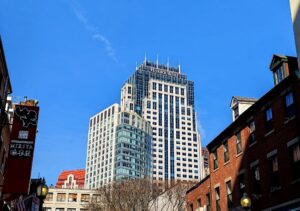Boston’s One Lincoln tower could be repurposed from substantially vacant to vibrant with a residential conversion, according to a study that points to a potential path for dozens of office buildings facing financial distress.
Architects and project managers determined that despite One Lincoln’s large floor plates, the income generated by a residential conversion would outweigh capital costs.
“We are under no circumstances saying this is an easy slam-dunk decision,” said Jennifer Schultz, a partner at law firm Nixon Peabody in Boston, which coordinated the study. “The conversions aren’t free, but is there another viable option than sitting on your hands and paying for a better tomorrow?”
The findings have implications not only for Boston’s largest distressed office property, but a generation of middle-aged office towers that are typically considered too large and impractical to retrofit as housing.
Many of the towers were built after 1970 and face similar fates as One Lincoln, as lenders near decisions whether to foreclose on troubled office buildings with diminished occupancy and income, Schultz said.
The current mortgage holder for One Lincoln, MSD Partners, submitted the only and highest bid of $400 million for the 36-story building near South Station at a foreclosure auction March 21. The tower has been struggling to fill vacant floors left behind by State Street Corp., which had occupied three-quarters of the nearly 1.1 million square-foot building until 2023.
Private equity firm HarbourVest leased 250,000 square feet in 2022, and will occupy 12 floors in the upper half of the building. Owner Fortis Property Group of New York received a refinancing package valued at $1 billion at the time of the lease.
How Conversion Could Work
Architects Gensler, construction managers AECOM Tishman and Cambridge-based owner’s project manager Collaborative RED participated in the study of alternative uses that could generate long-term income at One Lincoln and similar buildings.
The study focused on nine vacant floors in the mid-section of the tower, each spanning approximately 25,000 square feet. Such sizes are considered one of the major hurdles to a successful residential conversion, because of the need to locate living spaces near windows.
However, core building sections can be used as amenity spaces such as fitness rooms, dog spas and resident lounges, rather than being clustered on single floors, noted Todd Dundon, at principal at Gensler.
The study also factored in financial incentives offered by the city of Boston’s downtown office to residential conversion program, which offers property tax abatements to building owners to catalyze conversions.
All of the 760 housing units submitted under the program since it launched in late 2023 are located in older class B office buildings, which typically have smaller floor plates and higher vacancies.
“Our intent was to suggest that the office-to-residential conversions can happen in something other than older class B buildings,” Dundon said. “It solves a legitimate problem for the city, which is housing production.”
Conversion costs are estimated at $350 to $550 per square foot, Dundon said, including the need to upgrade building systems such as plumbing to add bathrooms for individual housing units.
Collaborative RED CEO Mark Mascia said quotes from subcontractors confirmed the financial feasibility of a residential project. Potential debt and equity investors also indicated the potential returns were sufficient, he said, although they would require a risk premium compared with a traditional ground-up housing project because the conversion play is unproven in Boston office towers thus far.
“Everybody has been touting the fluff aspect of this for years. This is the most analytical, detailed proof that this works,” Mascia said. “A post-2000, high-rise building can be economically repositioned to residential, and can do so for a lower cost basis than new construction at a similar quality layout and design standard.”
MSD did not return a message seeking comment on its future plans for One Lincoln.









